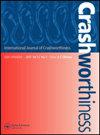Inclined battery cells for mitigating damage in undercarriage collision
IF 1.8
4区 工程技术
Q3 ENGINEERING, MANUFACTURING
引用次数: 0
Abstract
AbstractUndercarriage collision is dangerous for electric vehicle as battery pack is usually integrated into the vehicle floor. If battery pack is ploughed by obstacle on road, battery cells could be damaged, increasing risk of occurrence of internal short circuit and thermal runaway. To tackle the problem, we came up with inclined layout of battery cells for reducing damage in undercarriage collision. Using numerical simulations, we show why inclined battery cells can alleviate damage in undercarriage collisions. The load cases include vehicle’s initial speeds from 20 to 100 km/h and battery pack clearance overlapped with obstacle from 10 to 30 mm. Aligned with the new cell-to-pack packaging trend, the battery pack model used in this study only includes large size battery cells and has no module-level assemblies. A homogenised model of deformable battery cell was adopted for assessing damage. The results have shown that forward inclination of battery cells can reduce scraping resistance to battery pack, and thus lower the impact energy transferred to battery cells and jellyrolls. The 20° forward inclination was found to deliver better safety performance than the other layouts. Optimal inclination angle depends on structural design of battery pack and battery cells. In general, the safety enhancement is more prominent in severer undercarriage collisions.Keywords: Electric vehicleundercarriage collisionbattery safetyinclined battery cell AcknowledgmentsThe first author would like to express sincere thanks to Dr. Bobin Xing and Mr. Yuanjie Liu for their help in building the simulation model and conducting the analysis.Disclosure statementNo potential conflict of interest was reported by the author(s).Additional informationFundingThis study was funded by National Natural Science Foundation of China [Grant No. 52172405].倾斜式电池,可减轻底盘碰撞时的损坏
摘要电动汽车底盘碰撞的危险性很大,因为电池组通常集成在汽车底板中。如果电池组被道路上的障碍物碾过,可能会损坏电池组,增加发生内部短路和热失控的风险。为了解决这个问题,我们提出了倾斜布局的电池,以减少损坏的底盘碰撞。通过数值模拟,我们展示了为什么倾斜电池可以减轻底盘碰撞时的损伤。负载情况包括车辆的初始速度为20至100公里/小时,电池组与障碍物重叠的间隙为10至30毫米。与新的电池到电池组封装趋势一致,本研究中使用的电池组模型仅包括大尺寸电池,没有模块级组件。采用变形电池的均质化模型进行损伤评估。结果表明,电池芯的前倾可以降低电池组的刮擦阻力,从而降低传递给电池芯和水母的冲击能量。研究发现,与其他布局相比,前倾20°的布局具有更好的安全性能。最佳倾角取决于电池组和电芯的结构设计。总的来说,在严重的底盘碰撞中,安全性增强更为突出。关键词:电动汽车底盘碰撞电池安全性倾斜电池致谢第一作者对邢伯斌博士和刘元杰先生帮助建立仿真模型并进行分析表示衷心的感谢。披露声明作者未报告潜在的利益冲突。本研究由国家自然科学基金资助[批准号:52172405]。
本文章由计算机程序翻译,如有差异,请以英文原文为准。
求助全文
约1分钟内获得全文
求助全文
来源期刊

International Journal of Crashworthiness
工程技术-工程:机械
CiteScore
3.70
自引率
10.50%
发文量
72
审稿时长
2.3 months
期刊介绍:
International Journal of Crashworthiness is the only journal covering all matters relating to the crashworthiness of road vehicles (including cars, trucks, buses and motorcycles), rail vehicles, air and spacecraft, ships and submarines, and on- and off-shore installations.
The Journal provides a unique forum for the publication of original research and applied studies relevant to an audience of academics, designers and practicing engineers. International Journal of Crashworthiness publishes both original research papers (full papers and short communications) and state-of-the-art reviews.
International Journal of Crashworthiness welcomes papers that address the quality of response of materials, body structures and energy-absorbing systems that are subjected to sudden dynamic loading, papers focused on new crashworthy structures, new concepts in restraint systems and realistic accident reconstruction.
 求助内容:
求助内容: 应助结果提醒方式:
应助结果提醒方式:


